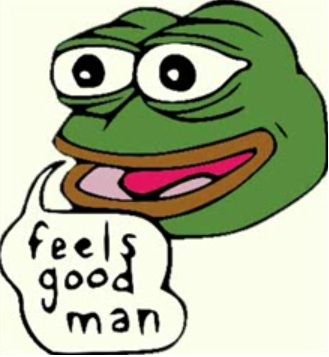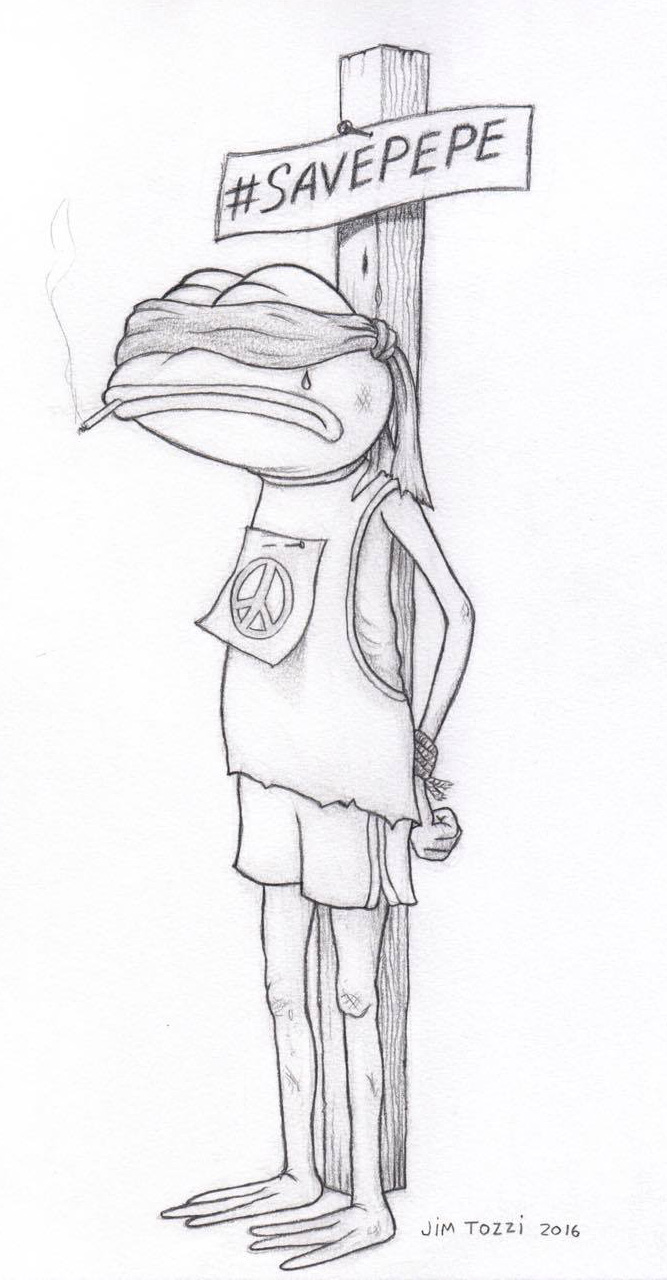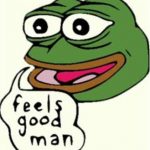Editor’s note: This story has a Part II, with updates on Pepe’s death!
In the waning days of last fall’s presidential election a frog took center stage. In early September, Donald Trump Jr. posted an image on Instagram featuring his father leading “The Deplorables.”
The image is intended to be a response to Hillary Clinton’s “basket of deplorables” remark. However, what catches one’s eye is a curious depiction of a green frog wearing a Trump wig. The Clinton campaign quickly pointed out that the frog is an instance of an internet meme known as Pepe the Frog and denounced Trump for his campaign’s usage of the meme due to its associations with white supremacy and the alt-right. Not long after, the Anti-Defamation League added Pepe to its online database of hate symbols.

“Feels Good Man”
Thanks to countless subsequent explainers—like this one from NPR—the history of Pepe may already be familiar to you. The meme has its origins in a comic strip by the artist Matt Furie. In around 2008 users of online message boards like 4chan began adapting one of the comic’s characters, an anthropomorphic frog, into a series of reaction images—most notably, Pepe saying “feels good man.”
Over time, users adapted the Pepe character into a number of different contexts, and the meme attained some measure of mainstream popularity. (See, for example, Katy Perry tweeting a Pepe in 2014.) Members of the original communities out of which Pepe emerged took umbrage with the meme’s new popularity and—likely out of a desire to troll mainstream internet users—began to associate Pepe with racist themes. Over time, their campaign worked. Pepe was taken up by white supremacists and those on the so-called “alt-right” on Twitter, Reddit, and other social networks. This led directly to Trump Jr.’s sharing of the photo and the subsequent controversy.
The moment was remarkable in that it was, to my knowledge, one of the first instances where the creation and dissemination of internet memes—formerly the province of rather harmless lolcats, advice animals, and photoshops—became a central topic of national political discourse. Yet despite the growing influence and significance of meme culture, there has been very little philosophical reflection on the topic. This is especially remarkable given that recent philosophy of art has given us powerful tools for theorizing these cultural objects—for thinking about both their nature and their value to the communities that perpetuate them.
Meme Ontology
Let’s begin with a basic question: what is Pepe the Frog? Put more generally, how should we understand the ontology of internet memes like Pepe? (I am going to use the term “meme” in a somewhat narrower sense than it is often used, to refer specifically to adaptable image-based memes like Pepe. Viral videos, hashtags, and reaction GIFs are also plausibly memes, but their ontological structure may differ from image-based memes in important ways that I won’t discuss here.)
We can first distinguish between specific instances of the meme—say, a specific image of Pepe posted to social media—and the meme itself. There is a difference between an individual “rare Pepe” image and the broader phenomenon of sharing images of Pepe online. I don’t think it would make sense to identify the meme with any set of individual shared instances. Instead, we should think of memes as abstract structures of a particular kind: Memes themselves are thematic templates or sets of instructions for generating particular instances—similar to the way a musical score indicates a structure governing the generation of individual performances. (To put it in terms borrowed from the ontology of music: memes are indicated structural types that govern the form and content of particular instances of the meme.) Consider the Advice Dog meme, an image-based meme consisting of a dog giving comically bad advice:

Advice Dog
The instructions that constitute the meme are rather simple:
- Image of dog at center of rainbow color wheel.
- First line of advice above dog.
- Second line of advice—usually a punchline—below dog.
Users of the meme then iterate this set of instructions, yielding a particular image which can be reproduced and disseminated.
Some memes are ontologically thick: that is, the set of rules strictly governs the form and/or content of what will count as a particular instance of the meme. Advice Dog and other advice animals are thick, in that the rules are fairly strict in specifying the structure and content of the particular instances. However, other memes—like Pepe the Frog—are ontologically thinner: they leave open a great deal of space for interpretation and revision on the part of the user in generating an instance of the meme.
There is one key difference between memes and musical works: the structure of musical works is usually fixed, whereas the structure of a meme is open-ended. Consider Terry Riley’s In C: the structure of the work, while ontologically thin, is nevertheless fixed by Riley’s original composition. Riley’s score provides correctness conditions for all further attempts to generate instances of the work in performance. Performances that diverge too radically from the structure will simply fail to be instances of the work.
Memes, on the other hand, are the product of collective authorship, and are furthermore open to collective revision over time. Consider how most memes get started: initially, a user “seeds” the meme by posting some image or images online. Other users, in viewing these initial images, abstract a structure which they can continue in much the same way that one can continue a sequence of numbers once one has discerned a pattern in the initial sequence. In the case of Pepe, the meme likely began when a user on 4chan posted an image of Pepe saying “feels good man” as response to a request for justification of their behavior. Other users began using the image in similar ways. It was at this point that the meme emerged as a pattern implicit in the activities of this community of users; competent users familiar with instances of the meme would be able to generate new instances consistent with the practices of the community.
Memes are open-ended in that there is no authoritative source beyond a community’s practice in generating and disseminating instances to fix the structure of the meme. Even in cases where an originator of the meme can be identified, there is little sense of ownership, authority, or responsibility for the meme attached to the originator themselves. This means that there is generally vagueness in what counts as an instance of the meme—as this largely depends on what a community will accept and recognize as such.
Furthermore, memes can evolve when users push the boundaries of the structures established in practice or intentionally deviate from them. Consider Pepe: variants such as smug frog, sad frog, and angry frog quickly emerged. Broadly consistent with the initial practice of posting Pepe’s image as a reaction image, these instances were recognizable as instances of the larger Pepe meme. The community of users began to circulate these new classes of instances; this had the result of expanding and changing the Pepe meme itself, perhaps making way for even more radical diversions from the initial structure of the meme.

Pepe variations (l to r): Sad Frog, Angry Frog, Smug Frog, Trump Pepe
Beyond a certain point this process of evolution might yield an entirely different meme, with different rules or conventions. It’s a difficult question to determine exactly when this occurs—and one that I don’t have a definite answer to. I suspect that the matter is likely vague and depends on the ontological thickness or thinness of the initial meme. For a meme as thin as Pepe—bound together perhaps only by the presence of the Pepe character—it seems likely both that there is an extraordinary range in what will count as an instance of the meme as well as a set of sub-memes of Pepe associated with more restricted structures and practices. On the other hand, for ontologically thicker memes like viral videos, there will be must stricter conditions for instancing the meme: if one has shared a video different than the original, one has instanced a different meme.
Community and Value
Why spend so much time thinking about the nature of internet memes? Plenty of critics remain unimpressed with the content of most memes, thinking of them—not without justification—as sophomoric and overly simplistic. While this is often true, I think that taking this perspective misses out on the distinctive value of the memetic form.
The real value of internet memes lies in their distinctive ability to generate a community: in creating or disseminating instances of memes, users take on a role in the community responsible for the collective authorship of the meme itself. Through their activity, they indicate that they are part of the group that understands and appreciates the meme; we share memes for the same reason that we tell inside jokes—we desire intimacy with other members of a community. We establish this intimacy by expressing our shared knowledge and common values through the meme-instances that we generate and propagate.
At the same time, in creating and disseminating instances of the meme users play a role in determining the nature of the meme through their activity. By creating new instances of a meme we can have an effect on community practice—and thereby on the structure of the meme itself. If the community accepts our variations on a meme’s structure as legitimate instances of that meme, then we’ve contributed to expanding the meme. On the other hand, we might reinforce the existing structure of the meme by generating and sharing instances consistent with established community practice. Sharing memes therefore provides us with a direct means of contributing to an artistic object that can have a meaningful and lasting cultural impact. (There is, furthermore, a kind of purity to this creative activity: Individual users are generally never credited for creating or disseminating instances of a meme.)
It’s worth underlining the curious and likely circular structure of this arrangement: memes are both a tool for constructing community, and are at the same time constructed and determined by the very community that they help to generate.
It’s notable that this community is a purely logical one; one can enter it simply by understanding and propagating a particular meme. It consists of all of the individual users involved in instancing, replicating, and disseminating the meme. This logical community may or may not overlap with existing real-world communities. Initially, the logical community is generally identical to the actual community in which a meme originates. However, given the speed and ease of replicating and disseminating instances of memes, memes can rapidly extend beyond the boundaries of an initial real-world community in which they originate. Pepe, for example, originated within the community of the image-posting message board 4chan. However, the community of users familiar with and participating in the Pepe meme spread virally, until Pepe became—like the ubiquitous lolcat—a meme familiar to many mainstream internet users.
This may go some way towards explaining the anger of 4channers as well as their attempts to generate instances that due to their offensive content would be largely unpalatable to mainstream users. In doing so, the 4channers’ aim was to reestablish the former boundaries of the abstract community—thereby recapturing a kind of intimacy within their actual community that had been lost once the meme went mainstream.
Saving Pepe

“Save Pepe” by Jim Tozzi
Where does this leave us with respect to Pepe? Has the meme been lost to the trolls for good? Perhaps not. Recently, Matt Furie—with the help of the Anti-Defamation League—has started a movement to rehabilitate Pepe. The movement has its own hashtag, #savepepe, and its aim is to “share positive images of the frog in an attempt to rehabilitate him and move his image out of the realm of hate speech.”
What’s especially interesting about the movement is that it essentially concedes that Furie himself—the author of Pepe’s source material—has no ultimate authority over the meme that he contributed to creating. Success in shifting the structure of the meme can’t be accomplished through authorial pronouncement; instead, it can only take place practically, by shifting the dominant practice of generating and disseminating instances of the meme. It’s only by re-entering the community and shifting its norms through our own activity that we can have an effect on the structure of the meme itself. Which, as it turns out, is an especially poignant metaphor for those hoping to reclaim other aspects of our culture from the alt-right. A cartoon frog providing lessons for the future of democratic culture—feels good man.
Read on in Part II: the death of Pepe!
Notes on the Contributor
Anthony Cross is a Lecturer in Philosophy at Texas State University. His research in the philosophy of art focuses on the ethical significance of our relationships with artworks and other cultural objects. He has further research interests in ethics and the history of philosophy, and he also spends way too much time on the internet.


